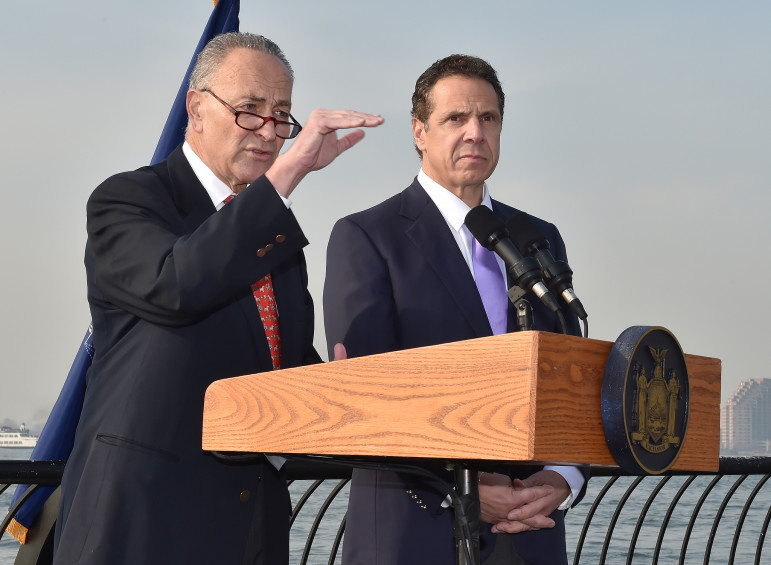
Kevin P. Coughlin/Office of the Governor
Both Sen. Charles Schumer (left) and Gov. Andrew Cuomo want to close Indian Point. But Schumer says there's not enough alternative power to do so, and, the author says, Cuomo has moved to slowly to tap into the energy resources that do exist.
In the never-ending battle to shut down the Indian Point nuclear reactors, the latest line of defense – recently articulated by Senator Charles Schumer—is that there is not sufficient replacement power.
I have been calling for the Indian Point nuclear power plant to be shut down for my entire adult life, since I helped start the NY Public Interest Research Group while a college student in 1973. Nuclear power is too expensive, too environmentally risky, and you have to figure out how to store the waste for more than 100,000 years – or about 10 times as long as human civilization has existed. It would be impossible in case of the worst accident to safely evacuate the 50 million people who live within 20 miles of the plant. The plant has operated significantly longer than initially planned – and old machines break down more frequently.
For more than a decade three successive governors – Eliot Spitzer, David Paterson and Andrew Cuomo – have called for the reactors to be shutdown. The state and local governments have sought to force its closure by refusing to certify evacuation plans and ruling that the plant’s water discharges kill too many fish. Yet the federal Nuclear Regulatory Commission keeps allowing the reactors to operate even though their permits to operate have expired.

No Backspace is City Limits' new blog featuring a recurring cast of opinion writers passionate about New York people, policies and politics. Click here to read more..
Even the meltdown of, and radiation leak from three Japanese nuclear reactors at Fukushima five years ago following an earthquake and tsunami was not enough to force the closing of the plant. The NRC subsequently identified Indian Point as one of the nuclear reactors most at risk from earthquakes.
Environmental groups such as Riverkeeper, Clearwater and Sierra Club have renewed their calls to shut the plant after a recent leak of radioactive water, the seventh operational incident in eight months. Groups also point out that the AIM natural gas pipeline is going to be constructed near the plant. Nuclear and pipeline safety experts have repeatedly warned that a pipeline rupture adjacent to Indian Point could result in a nuclear catastrophe similar to or worse than the Fukushima nuclear disaster.
Senator Schumer, however, said he opposed shutting down the plant – which he admits should never have been built – until it can be shown that there is sufficient replacement power. Otherwise consumes could see a 30 to 40 percent hike in rates.
State energy regulators however have already created the Indian Point Replacement Contingency Plan to address the replacement power issue. Half of the 2,000 MW presently produced by Indian Point will come from three natural gas power plants that were knocked off line by Hurricane Sandy but will be back on line shortly. New transmission line projects will account for another 4oo MW. Other power will be realized through various energy efficiency projects and a reduction in peak demand.
Entergy, the owners of Indian Point, have mounted a major direct-mail campaign throughout the region to build support to keep the facility open. Glossy brochures mailed out individually target the concerns of suburban soccer moms and asthma-suffering low-income residents of the Bronx. Partially as a result, a resolution in the New York City Council has stalled with fewer than half of the members agreeing to co-sponsor it.
Cuomo is also giving increasingly mixed messages about nuclear power. While the governor has pushed for the shutdown of the Indian Point reactors, he recently has proposed subsidies to continue operation of various upstate nuclear reactors whose owners want to shut them down. (Entergy, which owns Indian Point, plans to shut down the Fitzpatrick nuclear plant in Oswego County in January 2017.)
Cuomo wants to include nuclear as part of his pending Clean Energy Standards to promote renewables, despite the safety risks and waste-storage problems associated with the continued operation of nuclear reactors. Though the carbon footprint of a nuclear plant is smaller than that of a fossil-fuel power plant, significant amounts of fossil fuel are used indirectly in mining, milling, uranium fuel enrichment, plant and waste storage construction, decommissioning, and ultimately transportation and millennia-long storage of waste. Cuomo’s real motivation in subsidizing nuclear is to protect existing jobs these plants provide in upstate communities, along with the property tax payments made to local governments.
The real solution to the state’s energy problem remains a quicker and more robust transition to clean, renewable energy – which will create far more jobs and lower electric costs. While Cuomo can rightfully argue that he is doing as much as any other governor to combat global warming, his actions still fall far short of what is needed to avoid catastrophic climate change. The governor continues to resist a major commitment to build offshore wind farms off of Long Island. And both the city and state have failed to mandate energy retrofit to cut the carbon footprint of buildings. Buildings in New York City account for 75 percent of the city’s carbon footprint. Mandating buildings’ energy efficiency is the low-hanging fruit that will save thousands of megawatts of electricity currently powered by toxic and dangerous carbon and nuclear fuel.
Mark Dunlea is the founder and chairman of the Green Educational Legal Fund Inc. He was previously the executive director of the Hunger Action Network of New York State for 29 years.








6 thoughts on “No Backspace: Yes, New York Can Shut Down Indian Point!”
Can, but shouldn’t.
Nuclear energy is clean energy, shutting down a nuclear power plant will increase fossil fuel use and pollution while hurting the economy.
Any discussion of tsunami-forced meltdowns should include an estimate of the direct casualties in New York City should such a tsunami come through. Because if you want to talk about theoretical accidents, you’re going to have to include all the ones that are higher-probability than any significant contamination from Indian Point.
Shut down Indian Point and watch NYC go dark during the next heat wave.
Shut it down. It’s old and dangerous. every year it runs creates 50 tons of million years spent fuel rods wastes and 4 M tons of mining wastes. Lot of CO2 is emitted mining that ore too. Replacing it with solar and wind would save money, and eliminate the risk of a deadly multi trillion dollar nuclear disaster. The IAEA also predict a shortage of uranium in just ten years. There is plenty of reserve capacity in the grid to handle the shutdown in the meantime.
Upstate New York will be fine, when Indian Point closes, New York City will be in a world of hurt, but it is a situation of their own choosing. http://www.whec.com/news/upstate-new-york-secede/4137863/